Union Pacific Railroad
The Union Pacific Railroad (reporting marks UP, UPP, UPY) is a Class I freight-hauling railroad that operates 8,300 locomotives over 32,200 miles (51,800 km) routes in 23 U.S. states west of Chicago and New Orleans. Union Pacific is the second largest railroad in the United States after BNSF, with which it shares[2] a duopoly on transcontinental freight rail lines in the Western, Midwestern and West South Central United States.
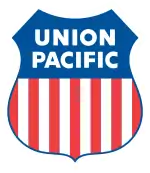 | |
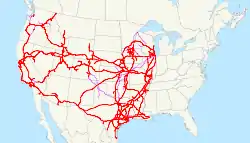 System map (trackage rights in purple) | |
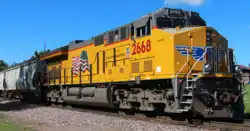 UP 2668, a GE ET44AH, photographed in June 2016 | |
| Overview | |
|---|---|
| Parent company | Union Pacific Corporation |
| Headquarters | Union Pacific Center, Omaha, Nebraska, United States |
| Reporting mark | UP (road locomotives), UPP (passenger cars), UPY (yard locomotives) |
| Locale | Western, Midwestern and Southern United States |
| Dates of operation | 1862–present
|
| Technical | |
| Track gauge | 4 ft 8+1⁄2 in (1,435 mm) standard gauge |
| Length | 32,100 miles (51,700 km) |
| Other | |
| Website | up.com |
Founded in 1862, the original Union Pacific Rail Road was part of the first transcontinental railroad project, later known as the Overland Route. Over the next century, UP absorbed the Missouri Pacific Railroad, the Western Pacific Railroad, the Missouri–Kansas–Texas Railroad and the Chicago, Rock Island and Pacific Railroad. In 1995, the Union Pacific merged with Chicago and North Western Transportation Company, completing its reach into the Upper Midwest. In 1996, the company merged with Southern Pacific Transportation Company, itself a giant system that was absorbed by the Denver and Rio Grande Western Railroad. The Union Pacific Railroad Company is the principal operating company of the Union Pacific Corporation, which are both headquartered at the Union Pacific Center, in Omaha, Nebraska.
History
Union Pacific in the 19th century
The original company, the "Union Pacific Rail Road", incorporated on July 1, 1862, under the Pacific Railroad Act of 1862. President Abraham Lincoln had approved the act, which authorized railroad construction from the Missouri River to the Pacific to ensure the stability of the Union throughout the American Civil War,[3] but construction did not complete until after that conflict's conclusion. The resulting track ran westward from Council Bluffs, Iowa to meet in Utah the Central Pacific Railroad line, which had been constructed eastward from Sacramento, California. The combined Union Pacific–Central Pacific line became known as the first transcontinental railroad and later the Overland Route.
The line was constructed primarily by Irish labor who had learned their craft during the recent Civil War.[4] Under the guidance of its dominant stockholder Dr. Thomas Clark Durant, the namesake of the city of Durant, Iowa, the first rails were laid in Omaha.[5] The two lines were joined at Promontory Summit, Utah, 53 miles (85 km) west of Ogden on May 10, 1869, hence creating the first transcontinental railroad in North America.[6]

Subsequently, the UP purchased three Mormon-built roads: the Utah Central Railroad extending south from Ogden to Salt Lake City, the Utah Southern Railroad extending south from Salt Lake City into the Utah Valley, and the Utah Northern Railroad extending north from Ogden into Idaho.[7]

The original UP was entangled in the Crédit Mobilier scandal, exposed in 1872. As detailed by the New York Sun, Union Pacific's largest construction company, Crédit Mobilier, had overcharged Union Pacific; the railroad would then pass the inflated costs on to the United States government. To convince the federal government to accept the increased costs, Crédit Mobilier had bribed multiple congressmen. Several prominent UP board members (including Durant) had been involved in the scheme.[8] The ensuing financial crisis of 1873 led to a credit crunch, but not bankruptcy.
As boom followed bust, the Union Pacific continued to expand. A new company, with dominant stockholder Jay Gould, purchased the old on January 24, 1880. Gould already owned the Kansas Pacific (originally called the Union Pacific, Eastern Division, though in essence a separate railroad), and sought to merge it with UP. Through that merger, the original "Union Pacific Rail Road" transformed into "Union Pacific Railway".[9]
Extending towards the Pacific Northwest, Union Pacific built or purchased local lines to reach Portland, Oregon.[10] Towards Colorado, it built the Union Pacific, Denver and Gulf Railway: a system combining narrow-gauge trackage into the heart of the Rockies and a standard gauge line that ran south from Denver, across New Mexico, and into Texas.
The Union Pacific Railway would later declare bankruptcy during the Panic of 1893. The resulting corporate reorganization reversed Gould's name change: Union Pacific "Railway" merged into a new Union Pacific "Railroad".[11][12]
Union Pacific in the 20th century
In the early 20th century, Union Pacific's focus shifted from expansion to internal improvement. Recognizing that farmers in the Central and Salinas Valleys of California grew produce far in excess of local markets, Union Pacific worked with its rival Southern Pacific to develop a spoilage-resistant rail-based transport system. These efforts came culminated in the 1906 founding of Pacific Fruit Express, soon to be the world's largest lessee of refrigerated railcars.[13]
Meanwhile, Union Pacific worked to construct a faster, and more direct substitute for the original climb to Promontory Summit. In 1904, the Lucin cutoff opened, reducing curvature and grades. The original route would eventually be stripped of track in 1942 to provide war scrap.[14]
To attract customers during the Great Depression, Union Pacific's chairman W. Averell Harriman simultaneously sought to "spruce up" the quality of its rolling stock and to make its unique locations more desirable travel destinations. The first effort resulted in the purchase of the first streamlined train: the M-10000.[15] The latter resulted in the Sun Valley ski resort in central Idaho; it opened in 1936 and finally was sold in 1964.[16][17] Despite the fact that the M-10000 and its successors were among the first diesel locomotives, Union Pacific completed dieselization relatively late. In 1944, UP finally received delivery of its last steam locomotive: Union Pacific 844.[18]
As the 20th century waned, Union Pacific recognized—like most railroads—that remaining a regional railroad would only lead to bankruptcy. On December 31, 1925, UP and its subsidiaries operated 9,834 miles (15,826 km) routes and 15,265 miles (24,567 km) tracks; in 1980, these numbers had remained roughly constant (9,266 route-miles and 15,647 track-miles).[19] But in 1982, UP acquired the Missouri Pacific and Western Pacific railroads, and 1988, the Missouri–Kansas–Texas.[20] By 1993, Union Pacific had doubled its system to 17,385 miles (27,978 km) routes.
By then, few large (class I) railroads remained. The same year that Union Pacific merged with the Chicago and North Western (1995), Burlington Northern and ATSF announced merger plans. The impending BNSF amalgamation would leave one mega-railroad in control of the west. To compete, UP merged with Southern Pacific, thereby incorporating D&RGW and Cotton Belt, and forming a duopoly in the West.[20] The merged railroad took the Union Pacific name. As of 1999, the UP had 33,705 miles (54,243 km) of track, about 33,000 employees, nearly 7,000 locomotives and over 155,000 rail cars.[21]
| UP[Note 4] | LNP&W | S&EV | P&IN | |
|---|---|---|---|---|
| 1925[22] | 12,869 | 10 | 3 | |
| 1933[22] | 8,639 | 4 | 0.4 | (into UP) |
| 1944[22] | 37,126 | 7 | 0.7 | |
| 1960[22] | 33,280 | (into UP) | (into UP) | |
| 1970[22] | 47,575 | |||
| 1979[23] | 73,708 | |||
| 1993[23] | 220,697 |
Facilities
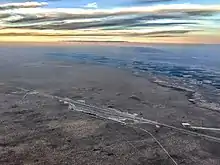
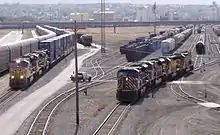
The Union Pacific system includes hundreds of yards. Most are flat yards used for local switching. Other types of yards include intermodal terminals and hump yards. Most UP intermodal terminals are typically ports, but UP also has inland terminals for transfers to trucks, such as the terminal in San Antonio that opened in 2009[24][25] or the one in Santa Teresa, New Mexico, that opened in 2014.[26]
Hump yards
In 2006, Union Pacific had 11 major active hump yards:[27]
- Bailey Yard in North Platte, Nebraska
- Beaumont Yard in Beaumont, Texas
- Davidson Yard in Fort Worth, Texas
- Davis Yard in Roseville, California
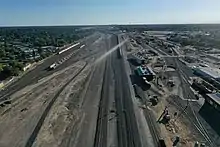
- Englewood Yard in Houston, Texas
- Gateway Yard in East St Louis, Illinois, owned by subsidiary Alton and Southern Railway
- Livonia Yard in Livonia, Louisiana
- North Little Rock Yard in North Little Rock, Arkansas
- Proviso Yard in Northlake, Illinois, owned by Chicago and North Western Transportation Company until 1995
- Strang Yard in La Porte, Texas
- West Colton Yard in Bloomington, California[28]
In the late 2010s, Union Pacific began deactivating hump yards in favor of flat switching. In this, Union Pacific followed the industry-wide trend towards Precision Scheduled Railroading (PSR); railway executive Hunter Harrison explained that under PSR, few yards receive enough variegated traffic to necessitate a hump.[29] Union Pacific also closed facilities in Kansas City ("Neff yard"), Hinkle, Oregon, and Pine Bluff, Arkansas in 2019.[30]
Locomotives and rolling stock
Union Pacific has owned some of the most powerful locomotives. These include members of the Challenger-type (including the 3985), and the Northern-type (including the 844), as well as the Big Boy steam locomotives (including the 4014). Union Pacific ordered the first diesel streamliner, the largest fleet of turbine-electric locomotives in the world, and the largest diesel locomotives ever built (including 6936).[31]
Paint and colors
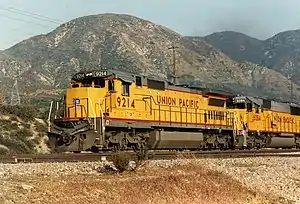
The yellow paint scheme was introduced in the spring of 1934. Engineers claimed the visibility of yellow would reduce grade crossing accidents.[32] In 1941, UP introduced its yellow and gray color scheme with red highlights, which remains in use today.[33]
The middle two-thirds of the locomotive body is painted Armour Yellow,[34] a color used by Armour and Company on the packaging of its meat products. A thin band of Signal Red divides this from the Harbor Mist Gray (a light gray) used for the body and roof above that point. There is also a thin band of Signal Red along the bottom of the locomotive body, but this color has gradually become yellow as new Federal Railroad Administration (FRA) regulations for reflectorized tape came into effect in 2005; the trucks (painted Aluminum from 1955 to 1982), underframe, fuel tanks and everything else beneath that line are also Harbor Mist Gray. Lettering and numbering are in Signal Red, with black outlines. Most locomotives have white-outlined blue "wings" on the nose, on either side of the renowned shield featuring white lettering on a blue background and, below it, red and white vertical stripes. Beginning in early 2002, a number of units were repainted with a large, billowing American flag with the corporate motto "Building America" on the side, where the 'UNION PACIFIC' lettering is normally positioned.
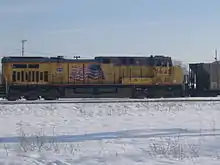
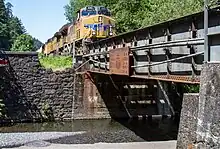
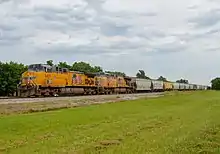
Merger partner locomotives
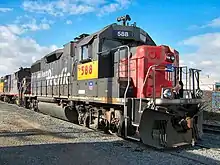
Until 2017, UP operated some locomotives still in the paint scheme of their former railroads. In addition, some locomotives were renumbered by UP, varying in the degree of the previous railroads' logos being eradicated, but always with a yellow patch applied over the locomotive's former number and a new UP number applied on the cab. That allowed UP to number locomotives into its roster without spending the time and money necessary to perform a complete repaint. In May 2015, UP rostered 212 "patches", consisting of:
- 22 Chicago and North Western (whose CNW logos have been hidden by the "patches"),
- 174 Southern Pacific (AC4400CW, GP40-2, MP15AC, and GP60)
- 14 St. Louis Southwestern (GP60)
- 2 Denver and Rio Grande Western (GP60)
- While not technically a predecessor locomotive in the traditional sense, UP also rostered a single SD40-2 (3564, since retired) still in the 1970s paint scheme, not counting DDA40X No. 6936, which was part of the Union Pacific Heritage Fleet until 2022.
In 2017, Union Pacific decided to repaint all locomotives which were not in the current corporate colors. As of March 2018, only 41 locomotives remained unpainted.[35]
Commemorative color schemes
From the second half of 2005 to the summer of 2006, UP unveiled a new set of six EMD SD70ACe locomotives in "Heritage Colors", painted in schemes reminiscent of railroads acquired by the Union Pacific Corporation since the 1980s. The engine numbers match the year that the predecessor railroad became part of the Union Pacific system. The locomotives commemorate the Missouri Pacific with UP 1982, the Western Pacific with UP 1983, the Missouri–Kansas–Texas with UP 1988, the Chicago and North Western with UP 1995, the Southern Pacific with UP 1996, and the Denver and Rio Grande Western with UP 1989.[36]
In October 2005, UP unveiled SD70ACe 4141, commissioned in honor of George Bush. The locomotive has "George Bush 41" on the sides and its paint scheme resembles that of Air Force One. It was sent into storage in 2007, but returned in 2018 to power Bush's funeral train. It was donated to the George H.W. Bush Presidential Library and Museum on November 8, 2019.[37][38]
On March 31, 2010, UP dedicated a specially painted GE ES44AC locomotive commemorating the centennial of the Boy Scouts of America.[39]
On September 28, 2010, UP dedicated a specially painted GE ES44AC locomotive, as a tribute to Susan G. Komen for the Cure.[40]
On October 19, 2017, Union Pacific unveiled SD70AH 1943, "The Spirit of the Union Pacific", which is painted in a scheme to honor the United States armed forces.
On June 6, 2019, Union Pacific unveiled SD70ACe 1111, the "Powered By Our People" unit.[41]
In April 2021, Union Pacific repainted an SD70M into a commemorative paint scheme called "We Are ONE" to honor Juneteenth and Pride Month.[42]
UP also has a collection of locomotives painted for Operation Lifesaver, a rail safety organization founded in 1970.[43]
2013 locomotive roster
As of October 2013, the Union Pacific had 8,185 locomotives on its active roster. The locomotive fleet consists of 43 different models and had an average age of 17.8 years.[44] According to Union Pacific, this is the largest fleet of diesel-electric locomotives in the US.[45]
| Type | Quantity |
|---|---|
| B40-8 | 91 |
| C40-8 | 333 |
| C40-8W | 50 |
| C41-8W | 154 |
| C4460AC | 80 |
| C44-9W | 274 |
| C44AC/CTE | 1,485 |
| C45AC/CTE | 943 |
| C6044AC | 176 |
| C60AC | 75 |
| GP15-1 | 160 |
| GP38-2 | 664 |
| GP38AC | 2 |
| GP39-2 | 49 |
| GP40 | 15 |
| GP40-2 | 142 |
| GP40-2P | 2 |
| GP40M-2 | 65 |
| GP50 | 48 |
| GP60 | 194 |
| MP15AC | 41 |
| MP15DC | 102 |
| SD40-2 | 505 |
| SD60 | 85 |
| SD60M | 560 |
| SD70ACe | 321 |
| SD70M | 1,445 |
| SD9043AC | 371 |
| SW1500 | 18 |
Heritage equipment
Union Pacific continues to use a small number of "heritage" steam locomotives and early streamlined diesel locomotives. This equipment is used on special charters (excursions).[46][47]
| Type | Quantity |
|---|---|
| 4-8-8-4 Big Boy | 1 |
| 4-8-4 FEF-3 | 1 |
| E9A | 2 |
| E9B | 1 |
.jpg.webp)
Low-emissions locomotives
Union Pacific maintains a fleet of low-emissions locomotives. Most are used in Los Angeles basin rail yards, to satisfy an air quality agreement with the local authorities.[48][49]
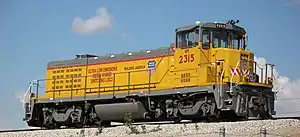
| Type | Quantity |
|---|---|
| 2GS14B | 1 |
| GP22T4 | 10 |
| MP20B | 13 |
| 3GS21B | 59 |
| PR30C | ≥6 |
| GG20GE | 21 |
| Others | ≤71 |
Facts and figures
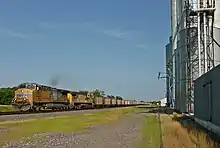
According to UP's 2007 Annual Report to Investors, at the end of 2007 it had more than 50,000 employees, 8,721 locomotives, and 94,284 freight cars.
Broken down by specific type of car, owned and leased:
- 35,437 covered hoppers
- 12,272 boxcars
- 18,647 open-top hoppers
- 13,780 gondolas
- 14,148 "other" types of cars
In addition, it owns 6,950 different pieces of maintenance of way work equipment. At the end of 2007, the average age of UP's locomotive fleet was 14.8 years, the freight car fleet 28 years.
UP was ranked 134th on the 2019 Fortune 500 list of the largest United States corporations by revenue and had 41,967 employees. The president of Union Pacific since August 14 2023 is Jim Vena.[50]
in 2019 Union Pacific has been rated the worst company to work for by 247wallst.com, citing Past CEO Lance Fritz's 12% approval rating and the 22% recommendation rating from Glassdoor.com.[51][52]
Passenger service
.jpg.webp)
Commuter services
When Union Pacific bought out the Chicago & North Western in 1995, it inherited the railroad's Metra commuter rail services in the Chicago metropolitan area: the UP North, UP Northwest, and UP West lines, all of which operate from the Ogilvie Transportation Center (the former North Western Station–a name still used by many Chicago residents). In order to ensure uniformity across the Chicago area commuter rail system, trains are branded as Metra services and use Metra equipment. However, Union Pacific crews continue to operate the trains under a purchase-of-service agreement.[53][54]
Former services
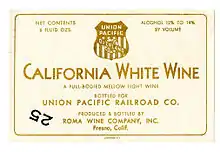
Between 1869 and 1971, Union Pacific operated passenger service throughout its historic "Overland Route". These trains ran between Chicago and Omaha on the Chicago & Northwestern trackage starting in 1936. Disputes over trackage rights and passenger revenues with the C&NW prompted the UP to switch to the Milwaukee Road for the handling of its streamliner trains between Chicago and Omaha beginning in late 1955. The last intercity passenger train operated by UP was the westbound City of Los Angeles, arriving at Los Angeles Union Station on May 2.[55] Since then, Union Pacific has satisfied its common carrier requirements by hosting Amtrak trains.[Note 5]
Hosted trains
Many Amtrak and commuter rail routes use Union Pacific rails. This list excludes the commuter services the company directly operates in Chicago (see above).
Amtrak
Notable accidents
21st century
- September 4, 2007: a Union Pacific train derailment split the small town of Sergeant Bluff, Iowa. About 16 cars derailed, most carrying salt that spilled into snow-like piles. The derailment interrupted traffic for about two hours.[57]
- June 24, 2012: three crew members died and caused a property damage of $15 million when two Union Pacific trains collided head-on just east of Goodwell, Oklahoma. The eastbound train passed a stop signal on the main track and struck the westbound train in a siding about one mile (1.6 km) east of the meeting point.[58] The NTSB provided the probable causes as eastbound train's operator's vision problems and failure by the conductor to get backup assistance as required. NTSB stated UP did not comply with its own policies when it medically recertified the operator. The company only had six color tests despite the policy requiring a color test for 10 signals.[59]
- November 15, 2012: A UP train struck a parade float in Midland, Texas, killing four and injuring 16 passengers on the parade float.
- May 25, 2013: in Chaffee, Missouri, a Union Pacific train collided with a BNSF train at a level junction, injuring seven, and causing damages exceeding $10 million. The accident caused a Missouri Route M overpass to partially collapse and caused a fire.[60][61] The investigation concluded the engineer most likely fell asleep, due to sleep apnea. The uncontrolled train violated four progressively more restrictive signals before colliding with the BNSF train at roughly 40 mph (64 km/h). Three months later, the Route M overpass reopened with a new design.[62][63]
- June 3, 2016: a 96-car oil train derailed in the Columbia River Gorge near Mosier, Oregon. Eleven cars derailed, at least one caught on fire, and 42,000 US gal (160 m3) of Bakken crude oil spilled, some going into the Columbia River. Some 10,000 US gallons (38 m3) were eventually recovered.
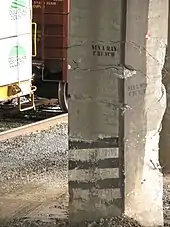 Support column damaged in September 2019 Portland accident
Support column damaged in September 2019 Portland accident - Mid-late 2018: the Niland Geyser, a moving mud pot, encroached on the railroad near the eastern shore of the Salton Sea, requiring extensive engineering work to first delay the movement and then build a temporary diversion.[64][65][66]
- September 7, 2019: a Union Pacific train of two locomotives and three tank cars carrying liquefied petroleum gas derailed and crashed into an overpass support column at the Albina Yard in Portland, Oregon[67][68] The support column is for the eastbound lanes of the six-lane Going Street overpass, which is the only public access to the major industrial area Swan Island for cars and trucks. Four lanes were left unsafe after the derailment.[69][70] Two of six lanes remain closed as of November 14, 2019.[71] The cause of the crash was broken rails.[72] There was nobody on board the train which was remotely operated at the time of crash.[70] In May 2020, another Union Pacific derailment damaged a different overpass which The Skanner described as an ongoing safety concern.[73]
- March 21, 2022: a Union Pacific freight train derailed and fell from a viaduct in Colton, California.[74]
San Antonio area
On June 28, 2004, a UP train collided with an idle BNSF train in a San Antonio suburb. In the course of the derailment, a 90-ton tank car carrying liquified chlorine was punctured. As the chlorine vaporized, a toxic "yellow cloud" formed, killing three and causing 43 hospitalizations. The costs of cleanup and property damaged during the incident exceeded $7 million.[75]
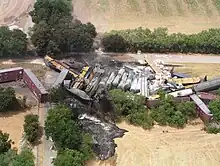
Investigations of the Macdona incident revealed several serious safety lapses on the part of the Union Pacific and its employees, including employees not following the company's own safety rules.[76] While the immediate cause of the derailment was the UP crew's "fatigue", chlorine tank cars had been improperly placed near the front of the train, a danger in the case of derailment.[77]
The Macdona incident was not the first derailment in the San Antonio area. Between May and November 1994, Union Pacific trains derailed five times, killing at least 4 people.[78] Between June 2004 and March 2005, 10 trains derailed, killing as many people.[79]
In the aftermath of Macdona, the Federal Railroad Administration signed a compliance agreement with the railroad in which the railroad promised to rectify the "notable deficiencies" that regulators found.[76][79] But the relative impunity UP seemed to exhibit regarding the derailment led to suggestions that the FRA was far "too cozy...to the railroads."[76] In March 2005, Texas Governor Rick Perry supported a plan to reroute trains around large urban population centers in Texas, including San Antonio, but such a plan was purely voluntary and had no timetable associated.[79]
Trains have continued to derail in the area[80][81][82] including an incident in June 2009 where tank cars containing chlorine and petroleum naptha xylene derailed, but did not spill.[83][84]
Community responsibility
Transient camp and graffiti issues
The City of San Jose, California, threatened Union Pacific with a lawsuit in 2019 after years of complaints about transient and graffiti blight going unaddressed. For the first time in many years, Union Pacific cleaned out along the tracks starting in November 2019. San Jose Councilman Sergio Jimenez said "The reality is that Union Pacific has not been a good neighbor".[85]
San Jose's mayor Sam Liccardo said
"At any given conference of mayors, you won't hear anyone expressing confidence that Union Pacific will respond nimbly or collaboratively," and "But we are hopeful that the (memorandum of understanding) will turn a page on Union Pacific's behavior in the past to enable a more collaborative relationship going forward."[86]
The Mercury News reports that company has been uncooperative and non responsive to working together, such as failing to come through with graffiti abatement as Union Pacific had promised the city.[85]
2022 Utah Legislative Action
In 2022, legislators in Utah brought forth two separate bills specifically aimed at Union Pacific. The first, HB181, was raised after some municipalities encountered resistance from Union Pacific when attempting to upgrade rail crossings. In Logan, Utah, Union Pacific altered a construction agreement to require the city to pay maintenance fees in perpetuity for an upgraded crossing, a mandate which was against state code.[87] The proposed legislation would make it easier for municipalities to get crossing improvements approved, and clarifies which party must pay associated maintenance costs. The second bill, HB405, would have required Union Pacific to replace their aging fleet of Tier 0 switching locomotives with hydrogen or electric engines by 2028, due to Utah having very poor air quality in winter months. According to Utah Senator Schultz, Union Pacific was uncooperative on the switching locomotive bill if Utah did not drop the railroad crossings bill. Ultimately, HB181 passed, and HB405 was dropped after Union Pacific made voluntary commitments to replace several tier 0 switching locomotives with less polluting tier 2 locomotives, as well as to test some all electric ones in the Utah Roper Rail Yard.[88][89]
Environmental record
In Eugene, Oregon, where pollution from a century-old rail yard has been seeping into groundwater, the UP and the Oregon Department of Environmental Quality launched a study of ground contamination in 2008. The pollutants are mostly petroleum hydrocarbons, industrial solvents, and metals.[90]
In 2007, Union Pacific Railroad worked with the US EPA to develop a way to reduce locomotive exhaust emissions. They discovered that adding an oxidation catalyst filtering canister to the diesel engine's exhaust manifold and using ultra-low-sulfur diesel fuel would reduce particulate emissions by about half, unburned hydrocarbons by 38 percent, and carbon monoxide by 82 percent.[91]
The company's Fuel Master program rewards locomotive engineers who save the most fuel each month. The program has saved the company millions of dollars, much of which has been returned to the engineers. In 2006, the program's founder, Wayne Kennedy, received the John H. Chafee Environmental Award, and the program was recognized by Transportation Secretary Norman Mineta.[92]
In January 2018, a former waste water operator at Union Pacific Albina Yard in Portland, Oregon, employed by the railroad's contractor Mott MacDonald negligently released thousands of gallons of oil into the environment. The operator was distracted by a cell phone and allowed the tank to overflow for over an hour. An engineering firm hired by Union Pacific estimates 1,800 U.S. gallons (6,800 liters) of it was released into nearby Willamette River, not including the spill that was captured by the containment booms. Employees of United States Environmental Protection Agency who were working at facilities nearby placed booms to contain the oil spill. Federal prosecutors have charged the operator Robert LaRue Webb II with violation of the Clean Water Act for releasing the oil into the environment. Webb pleaded guilty in August 2019,[93] and was sentenced to two years probation and a $2,500 fine.[94][95][96]
In 2016, the Union Pacific Railroad Co. was named as a defendant in a lawsuit seeking cleanup of a contaminated rail yard site that operated in Lafayette, Louisiana, from the late 1800s until the 1960s.[97]
In 2020, Houston residents living near a Union Pacific Railroad Company rail yard filed lawsuits against the Union Pacific. These lawsuits followed the finding by the State of Texas of a higher-than-expected incidence of certain cancers in residents living close to the yard.[98] A State of Texas report released in 2021 identified an additional cancer cluster of lymphoblastic leukemia in children.[99]
EMP
Union Pacific and Norfolk Southern are the largest owner-partners of Equipment Management Pool (EMP), a domestic freight interline intermodal freight transport service that rents and moves more than 35,000 53-foot containers and chassis throughout North America. Other partners in the freight company include Canadian National Railway, I&M Rail Link, Iowa Interstate Railroad, Wisconsin Central Ltd., and Kansas City Southern Railway.[100][101][102] In 2022, Canadian Pacific Railway was dropped from the pool, leaving CN as the only Canadian member.[103][104]
Union Pacific Railroad Museum
.jpg.webp)
The Union Pacific Railroad Museum is a former Carnegie library in Council Bluffs, Iowa that houses artifacts, photographs, and documents that trace the development of the railroad and the American West.[105] The company pays upkeep on the privately owned building, which houses part of Union Pacific's corporate collection, one of the oldest in the United States. Holdings include weapons from the late 19th and 20th centuries, outlaw paraphernalia, a sampling of the immigrants' possessions, and a photograph collection comprising more than 500,000 images.[106]
See also
- Central Pacific Railroad
- First transcontinental railroad
- Hell on Wheels (TV series involving Union Pacific set in 1865)
- History of rail transportation in California
- Kansas Pacific Railway
- Los Angeles and Salt Lake Railroad
- Missouri–Kansas–Texas Railroad
- Missouri Pacific Railroad
- Oregon Railroad and Navigation Company
- Oregon Short Line
- Pacific Fruit Express
- Railex
- Southern Pacific Transportation Company
- Sun Valley, Idaho
- Western Pacific Railroad
Notes
- Includes subsidiaries Oregon Short Line Railroad, Oregon Railroad and Navigation Company, Los Angeles and Salt Lake Railroad, and St. Joseph and Grand Island Railway, but not jointly-owned subsidiaries Spokane International Railroad or Mount Hood Railroad.
- Does not include LNP&W, S&EV, or P&IN
- Does not include jointly-owned subsidiaries Spokane International Railroad or Mount Hood Railroad; entry for 1993 includes all subsidiaries
- Includes subsidiaries Oregon Short Line Railroad, Oregon Railroad and Navigation Company, Los Angeles and Salt Lake Railroad, and St. Joseph and Grand Island Railway.
- Merger partner D&RGW elected not to join Amtrak and continued operating the Rio Grande Zephyr until 1983.[56]
- This service runs on its own dedicated tracks within a UP right of way.
References
- "EMPLOYER STATUS DETERMINATION Union Pacific Railroad Company Southern Pacific Transportation Company" (PDF). Railroad Retirement Board.
- "Company Overview". Union Pacific Corporation. December 31, 2013. Retrieved March 27, 2014.
- "An Act to aid in the construction of a railroad and telegraph line from the Missouri river to the Pacific ocean, and to secure to the government the use of the same for postal, military, and other purposes Archived May 27, 2016, at the Wayback Machine 12 Stat. 489, July 1, 1862
- Collins, R.M. (2010). Irish Gandy Dancer: A tale of building the Transcontinental Railroad. Seattle: Create Space. p. 198. ISBN 978-1-4528-2631-8.
- Progress of the Union Pacific railroad west from Omaha, Nebraska, across the continent, making,: with its connections, an unbroken line from the Atlantic to the Pacific Ocean (Pamphlet ed.). 15 Vandewater Street, L. O.: C. A. Alvord. April 2, 1868. p. 5.
This aid was given to two powerful companies, viz., to The Union Pacific Railroad Company, building from Omaha, on the Missouri river, West; and to The Central Pacific Railroad Company of California, building from Sacramento, East.
{{cite book}}: CS1 maint: location (link) Text taken from OCR; may be corrupt. - "Ceremony at "Wedding of the Rails," May 10, 1869 at Promontory Point, Utah". World Digital Library. May 10, 1869. Retrieved July 20, 2013.
- Solomon, Brian (2000). Union Pacific Railroad. Osceola, WI: MBI. p. 36. ISBN 978-0-7603-0756-4.
- Crawford, Jay Boyd (1880). The Credit Mobilier of America: Its Origin and History. Boston: C. W. Calkins & Co. p. 101.
- Ripley, William Zebina (1915). Railroads: Finance and Organization. New York: Longmans, Green, & Company. pp. 249–250.
gould.
- "PNWC-NRHS". Oregon-Washington Railroad & Navigation Company. Retrieved September 7, 2018.
- Solomon, Brian (2000). Union Pacific Railroad. Voyageur Press. pp. 35–43. ISBN 9781610605595.
- "Post-Construction". Union Pacific. Archived from the original on September 8, 2018. Retrieved September 7, 2018.
- "Pacific Fruit Express Company Forms". Union Pacific. Retrieved September 7, 2018.
- "Lucin Cutoff Opens". Union Pacific. Retrieved September 7, 2018.
- "M-10000 Streamliner Debuts". Union Pacific. Retrieved September 7, 2018. See also in the sidebar: "By 1936, Union Pacific’s shiny new Streamliners had begun to attract passengers back to the railroad, but the Depression was keeping passenger counts low."
- "Union Pacific Railroad invention still takes skiers to the top". Union Pacific Railroad. November 29, 2010. Retrieved June 9, 2017.
- Lund, Morten (2000). "An extraordinary history of Sun Valley". Skiing Heritage Journal. pp. 20–25.
- "UP Receives Its Last New Steam Locomotive". Union Pacific. Retrieved September 7, 2018.
- 1980 mileage is from Moody's Transportation Manual (1981); the ICC's Transport Statistics says Union Pacific System operated 8,614 route-miles at year end 1980, but the 1979 issue says 9,315 route-miles and the 1981 says 9,096, so their 1980 figures look unlikely.
- "Mergers since 1980". Trains. 76 (11): 31. November 2016. ProQuest 1820289392. (Sidebar on "Transcon Mergers" article.)
- Solomon, Brian (2000). Union Pacific Railroad. Voyageur Press. p. 7. ISBN 978-1610605595.
- ICC annual reports
- Moody's report
- Arbona, Joe (August 22, 2007). "Union Pacific Begins Construction of $90 Million State-of-the-Art Intermodal Terminal in Southwest Bexar County". San Antonio, Texas: Union Pacific. Retrieved April 2, 2015.
- Espinoza, Raquel (March 11, 2009). "Union Pacific Railroad Opens New San Antonio Intermodal Terminal". San Antonio, Texas: Union Pacific. Retrieved September 7, 2015.
- "Rockin' and Railroading at the Santa Teresa Intermodal Facility". up.com. Union Pacific. Retrieved October 6, 2021.
- "North America's Hump Yards". Trains. July 8, 2006. Archived from the original on December 4, 2008. Retrieved January 13, 2015.
- "West Colton Yard" (PDF) (Press release). Union Pacific. Archived from the original (PDF) on June 6, 2019. Retrieved June 11, 2019.
- Ziobro, Paul (April 18, 2017). "New CSX CEO Shakes up the Railroad, Starting with 'Hump Yards'". Wall Street Journal.
'Hump yards are very complicated and expensive and work when you're bringing things in from lots of directions'...'The more you do preblocking, the more you don't need the complexity-solving machine that is a hump yard.'
- Cordes, Henry J. (October 20, 2019). "Union Pacific sees 'outstanding' results 1 year into efficiency push, but workforce has been cut 13%". North Platte Telegraph. Retrieved October 26, 2019.
- Brian Solomon (1981). Union Pacific Railroad. Voyageur Press. p. 91. ISBN 9781610605595.
- Union Pacific Bulletin. UPRR. 1950. p. 13.
New Dress for Spring in 1934. Since that time, all streamliner passenger equipment has been painted the ... Yellow is widely used where high visibility is desired as a safety feature. Union Pacific engineers claim that use of yellow on U.P. trains will further reduce the incidence of grade crossing accidents, especially at night. Nighttime visibility is increased still more by use of red reflection Union
- Welsh, Joe. Union Pacific's Streamliners. Voyageur Press. p. 59. ISBN 978-1-61673-115-1.
- Strack, Don (August 25, 2015). "Armour Yellow on Union Pacific". UtahRails.net. Retrieved June 23, 2022.
- Guss, Chris (March 2018). "Perfecting a unified look". Trains. 78 (3): 14. ProQuest 1988415135.
- "Denver & Rio Grande Western Colors Again Ride the Rails" (Press release). Union Pacific Railroad. June 19, 2006. Retrieved April 20, 2010.
- Wrinn, Jim (November 8, 2019). "Union Pacific donates SD70ACe No. 4141 to George H.W. Bush Presidential Library; Big Boy 4014 joins celebration". TrainsMag.com. Archived from the original on September 28, 2020. Retrieved November 8, 2019.
- "Union Pacific Donates George H.W. Bush Engine 4141 To The Bush Library And Museum". wtaw.com. Archived from the original on November 9, 2019. Retrieved November 9, 2019.
- "Union Pacific Railroad Unveils No. 2010 Boy Scouts of America Commemorative Locomotive" (Press release). Union Pacific Railroad. March 31, 2010. Retrieved April 20, 2010.
- "Union Pacific Railroad Unveils Its Pink Ribbon Locomotive" (Press release). Union Pacific Railroad. September 28, 2010. Retrieved May 12, 2012.
- "UP unveils 'Powered by our People' special paint scheme | Trains Magazine". Archived from the original on June 8, 2019. Retrieved June 8, 2019.
- ""We Are ONE" Commemorative Locomotive Debuts". Union Pacific. May 27, 2021. Retrieved April 15, 2022.
- Bogdanich, Walt; Nordberg, Jenny (January 23, 2005). "Highway Agency Disavows Claims by Rail Safety Group". The New York Times. ISSN 0362-4331. Retrieved June 23, 2022.
- [Trains Locomotive 2013]
- "Train Pride". Union Pacific. Retrieved September 7, 2018.
Today Union Pacific operates the largest diesel-electric fleet in the United States.
- "UP: Steam". Union Pacific. Retrieved September 7, 2018.
- "E-9 Streamliners". Union Pacific. Retrieved September 7, 2018.
- "New Ultra-Low Emission Locomotive Goes to Work in Union Pacific's Los Angeles Basin Rail Yards". Union Pacific. Retrieved January 19, 2017.
- Guss, Chris (August 2018). "Few flowers for gensets". Trains. 78 (8): 18–19. ProQuest 2056018178.
- "Executive Profiles". UP.com. Retrieved March 21, 2020.
- "Union Pacific". Fortune. Archived from the original on November 18, 2018. Retrieved November 18, 2018.
- Parker, Garrett (August 20, 2019). "The 20 Worst Companies to Work For in 2019". Money Inc. Retrieved February 13, 2020.
- Lassen, David (July 22, 2020). "STB filings detail Metra, UP disagreement (updated)". Trains Magazine. Archived from the original on July 29, 2020. Retrieved July 29, 2020.
- "Metra History". Metra. August 10, 2018. Archived from the original on March 8, 2019. Retrieved August 10, 2018.
- See Solomon, Brian, Railroad Color History: Union Pacific Railroad, p. 72 (photo of last westbound City of Los Angeles taken at Las Vegas on May 2, 1971). MBI Publishing, 2000.
- "Scenic route to be taken by Amtrak". Eugene Register-Guard. March 17, 1983. Retrieved September 12, 2010.
- Alicia Ebaugh, Journal staff writer (September 4, 2007). "Derailment cuts traffic in Sergeant Bluff". Sioux City Journal. Retrieved October 29, 2015.
- "NTSB: Why didn't train wait before Oklahoma crash?". The Washington Times. June 26, 2012. Retrieved July 19, 2012.
- "Train engineer's vision problems led to deadly Oklahoma wreck, NTSB rules". Oklahoman.com. June 18, 2013. Retrieved November 2, 2019.
- "NTSB Launches Go-Team to Missouri to Investigate Collision Between Two Freight Trains That Partially Collapsed a Highway Overpass". National Transportation Safety Board. Retrieved May 26, 2013.
- Hendricks, Christy. "NTSB investigating after train collision, overpass collapse in Scott County". KFVS12. Archived from the original on December 1, 2017. Retrieved May 26, 2013.
- "HQ-2013-13 (Finalized) | FRA". Archived from the original on April 6, 2016. Retrieved 2016-03-27.
- "Local News Releases". Archived from the original on April 12, 2016. Retrieved March 27, 2016.
- Reyes-Velarde, Alejandra; Lin II, Rong-Gong (November 1, 2018). "A San Andreas fault mystery: The 'slow-moving disaster' in an area where the Big One is feared". Los Angeles Times.
- Andrews, Robin George (November 9, 2018). "A bubbling pool of mud is on the move, and no one knows why". National Geographic.
- Francuch, Dean G; Deane, Travis; Zamora, Carol (2019). "The meandering Mundo Mud Pot: Or how Salton Sea tectonics affect international trade". Proceedings of the 70th Highway Geology Symposium: 439–456.
- "Union Pacific train with liquefied gas derails in Portland". Associated Press. September 7, 2019. Retrieved September 9, 2019.
- "Union Pacific train derails in Portland's Albina Yard, cracks support beam of overpass". Fox 12 Oregon. September 7, 2019. Retrieved September 9, 2019.
- Young, Molly (September 8, 2019). "Swan Island traffic could be backed up for months after train slams into vital Going Street bridge". The Oregonian. Retrieved September 9, 2019.
- Theen, Andrew (September 25, 2019). "Portland approves $1 million repair contract for Going Street bridge smashed by train". oregonlive. Retrieved October 16, 2019.
- Stein, Rosemarie (November 14, 2019). "Portland metro Thursday traffic: PBOT gets a fourth lane open on Going Street Bridge". oregonlive. Retrieved January 6, 2020.
- "Union Pacific identifies broken rail as cause of Portland train derailment, crash into columns". Fox 12 Oregon. September 9, 2019. Retrieved September 10, 2019.
- Sorenson, Saundra. "Three-Car Derailment in North Portland Signals Ongoing Safety Concerns". The Skanner News. Retrieved October 14, 2020.
- "Freight train derails in Colton". KTLA. March 21, 2022. Retrieved March 22, 2022.
- "Chlorine Rail Car Incident" (PDF). Aristatek. Retrieved April 18, 2010.
- Nordberg, Jenny; Bogdanich, Walt (November 17, 2004). "Regulators Plan to Step Up Union Pacific Safety Checks". The New York Times.
- "NTSB – Remarks by Robert L. Sumwalt". National Transportation Safety Board. Retrieved April 19, 2010.
- "Man Killed in Fifth Train Derailment in San Antonio Since May". The New York Times. November 11, 2004. Retrieved April 18, 2010.
- Bogdanich, Walt (March 19, 2005). "Texas Has Pact With Railroad To Move Lines". The New York Times.
- "Train derailment leaves big mess". pro8news. Archived from the original on March 8, 2010. Retrieved April 18, 2010.
- "Train derails near New Braunfels". San Antonio Express News. Retrieved April 18, 2010.
- Davila, Vianna (November 4, 2009). "UP train derails in Atascosa County". San Antonio Express News. Archived from the original on September 4, 2012. Retrieved April 18, 2010.
- "Train derails near Schulenburg, spills chemical". The Victoria Advocate. Retrieved April 15, 2010.
- "Schulenburg Train Derailment". United States Environmental Protection Agency. Retrieved April 18, 2010.
- "San Jose: In tense meeting, Union Pacific tells residents night horns will continue". The Mercury News. June 5, 2019. Retrieved March 21, 2020.
- "San Jose homeless encampments cleared along Union Pacific railroad tracks". The Mercury News. December 14, 2019. Retrieved March 21, 2020.
- Webb, Kat (June 20, 2022). "New Traffic Signal Left on 'Red': Logan Claims Union Pacific Trying to Railroad Them with Perpetual Fees". The Herald Journal. Retrieved June 25, 2022.
- "Utah Lawmakers, Union Pacific Make Nice: Bill to Force Clean Switchers Put on Hold". Deseret News. March 1, 2022. Retrieved June 25, 2022.
- "Utah Bill Aimed at Union Pacific Switch Engines Placed on Hold". Trains. March 2, 2022. Retrieved June 25, 2022.
- "Union Pacific Railyard Cleanup, Eugene". Oregon Department of Environmental Quality. Archived from the original on May 26, 2008. Retrieved March 29, 2009.
- "Union Pacific Tests Exhaust Catalyst on Locomotives". Environmental Leader. January 18, 2007. Archived from the original on October 9, 2008. Retrieved May 8, 2008.
- "Green Car Congress: DOT Secretary Commends Union Pacific's Conservation Program, Says US Needs to Go on Energy Diet". GreenCarCongress.com. BioAge Media. Retrieved October 29, 2015.
- "Portland Man Pleads Guilty to Clean Water Act Violation for Discharging Oil into Willamette River". Department of Justice - U.S. Attorney's Office. August 5, 2019. Retrieved November 4, 2019.
- Bernstein, Maxine (June 24, 2019). "Union Pacific plant operator allowed thousands of gallons of oil to spill into Willamette River, feds say". oregonlive. Retrieved November 2, 2019.
- Bernstein, Maxine (October 28, 2019). "Former Union Pacific Plant Officer Who Allowed Gallons of Oil to Seep into Willamette River Gets Probation". oregonlive. Retrieved November 2, 2019.
- "Ex-Railroad Plant Operator Who Allowed Oil Spill Sentenced". AP NEWS. October 29, 2019. Retrieved November 2, 2019.
- Burgess, Richard (February 5, 2016). "Landowners sue to get Lafayette railroad yard cleaned up, concerned about contamination of aquifer: Potential threat to Chicot Aquifer cited". The Advocate. Retrieved November 9, 2021.
- "Residents Sue Union Pacific, Others over Cancer Deaths". NewsBank. Houston Chronicle. September 19, 2020. Retrieved November 9, 2021.
{{cite web}}:|first=missing|last=(help) - Ernst, Sara Willa (February 3, 2021). "'We Know What We Want': 5th Ward Residents Demand Action after Another Confirmed Cancer Cluster". Houston PBS. Retrieved November 9, 2021.
- "EMP Domestic Container Program". Archived from the original on March 4, 2016. Retrieved 2015-01-02.
- "Domestic Equipment/EMP | NS Services | Intermodal | Shipping Options | Norfolk Southern". Archived from the original on July 11, 2016. Retrieved January 2, 2015.
- "CPR Increases Intermodal Options through the EMP Container Program". Archived from the original on August 1, 2016. Retrieved 2015-01-02.
- "Union Pacific drops Canadian Pacific from EMP intermodal program". Trains. September 19, 2022. Retrieved June 7, 2023.
- "Sole Canadian Partner in UP/NS EMP Program". Canadian National Railway. Retrieved June 7, 2023.
- "Museum History". UPRR Museum. Retrieved September 7, 2018.
- "U.P. History and Photos". Retrieved April 2, 2017.
Further reading
| Library resources about Union Pacific Railroad |
- Ambrose, Stephen E. (2000). Nothing Like It In The World; The men who built the Transcontinental Railroad 1863–1869. Simon & Schuster. ISBN 978-0-684-84609-5.
- Athearn, Robert G. (1971). Union Pacific Country (Reprinted ed.). Lincoln: University of Nebraska Press. ISBN 978-0803208582. – covers impact of the railroad on the region it served from the 1860s to the 1890s.
- Cahill, Marie; Piade, Lynne, eds. (1994). The history of the Union Pacific : America's great transcontinental railroad. New York: Smithmark. ISBN 9780831737993. – heavily illustrated
- Collins, Ryan Michael (2011). Irish Gandy Dancer : A Tale of Building the Transcontinental Railroad. Charleston, S.C.: Createspace. ISBN 9781452826318.
- Cooper, Bruce C., ed. (2004). Riding the Transcontinental Rails : Overland Travel on the Pacific Railroad, 1865-1881. Philadelphia: Polyglot Press. ISBN 978-1-4115-9993-2.
- Galloway, John Debo (1989). The first transcontinental railroad : Central Pacific, Union Pacific. New York: Dorset Press. ISBN 9780880294096.
- Kelly, John (2009). Union Pacific Railroad : passenger trains of the city fleet photo archive. Hudson, Wis.: Iconografix. ISBN 978-1-58388-236-8.
- Klein, Maury (2006) [1989]. Union Pacific: Volume 1, 1862-1893. Minneapolis: University of Minnesota Press. ISBN 9780816696635. – the standard scholarly history
- Klein, Maury (2006) [1989]. Union Pacific: Volume II, 1894-1969. Minneapolis, Minnesota: University of Minnesota Press. ISBN 978-0-8166-4460-5.
- Klein, Maury (2011). Union Pacific the reconfiguration : America's greatest railroad from 1969 to the present. New York: Oxford University Press. ISBN 9780199708581.
- Mitchell, Thomas Warner (August 1907). "The Growth of the Union Pacific and Its Financial Operations". The Quarterly Journal of Economics. 21 (4): 569–612. doi:10.2307/1883588. JSTOR 1883588.
- Perry, John D.; Wright, William Wierman; LeConte, John Lawrence (1868). Letter of John D. Perry, President of the Union Pacific Railway, Eastern ... Union Pacific Railway: Reports Showing the Necessity and Advantages of its Construction to the Pacific By Union Pacific Railway, Eastern Division, President. Philadelphia: Review Printing House. Retrieved February 19, 2011.
- White, Richard (2011). Railroaded: The Transcontinentals and the Making of Modern America. W. W. Norton & Company. ISBN 978-0-393-06126-0.
- Winchester, Clarence, ed. (1936), "North American Railroads", Railway Wonders of the World, pp. 1533–1542, OCLC 580319 illustrated account of the Union Pacific and other North American Railroads
External links
- Official website

- Business data for Union Pacific: